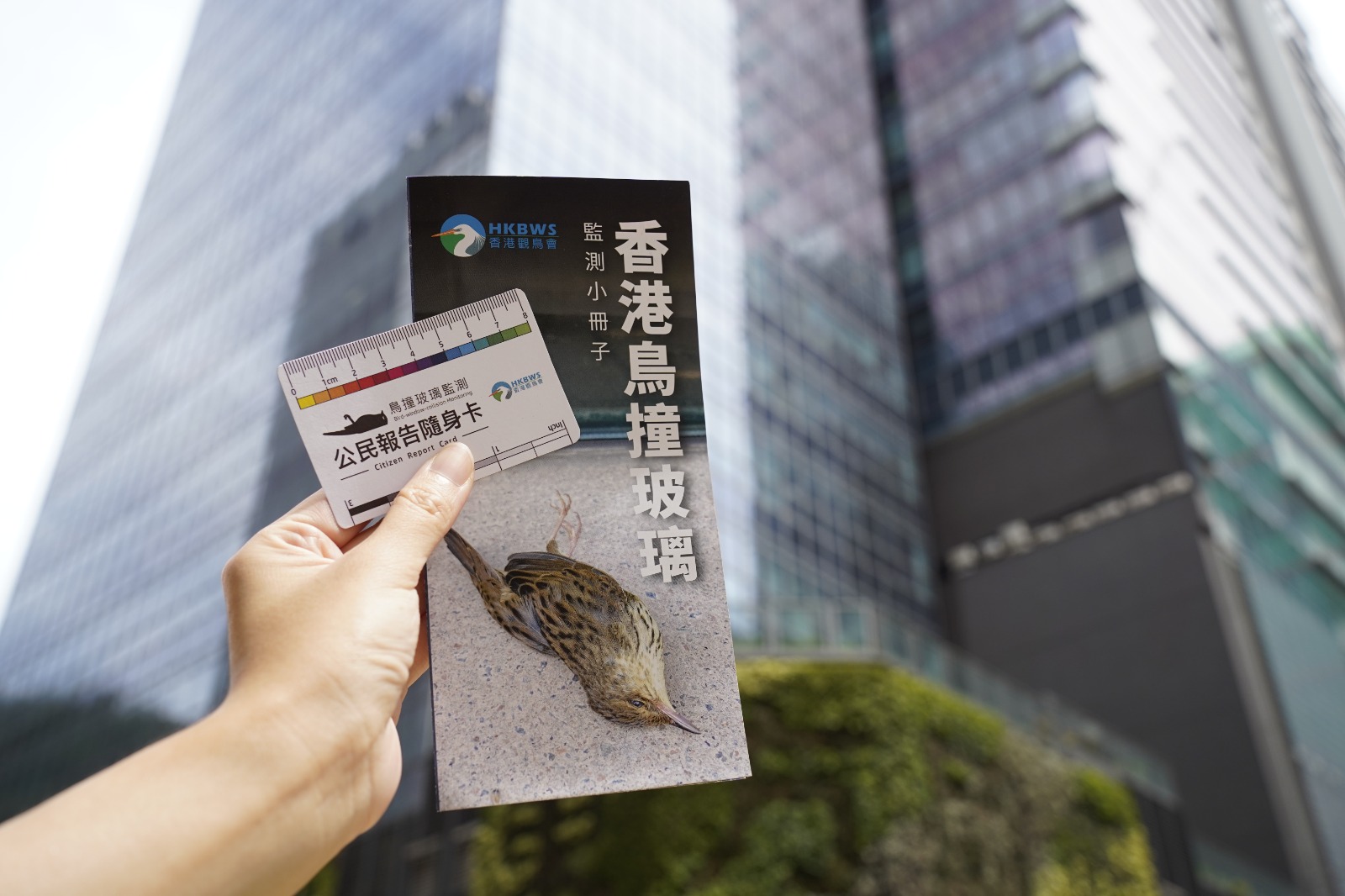309 victims of local bird-window collisions recorded in a single year
HKBWS advocates for legal regulations in new buildings
[26 September 2024, Hong Kong] The Hong Kong Bird Watching Society (HKBWS) has released the “Report on Hong Kong Bird-window Collision 2022-2023” (the report), where local Bird-window collision (referred to as bird collision below) data in the span of a year is compiled and analysed. This report pointed out that the extensive application of glass materials in urban development may pose a threat to biodiversity and urged for the study on new legislations on the planning and design of new buildings to effectively halt bird collisions.
284 deaths and 25 injuries recorded in a year while over 30% of birds are species of conservation concern
Bird-window collision is a phenomenon where birds fail to recognize glass as a barrier, attempt to pass through and collide with the glass structure in the process. This could result in injury or death. Compiling the 249 bird collision cases from 1 September 2022 to 31 August 2023, 16 districts in Hong Kong have been recorded with bird collisions with a total of 309 individuals involved (284 dead, 25 injured), and 69 imprints (i.e. feather dust, feathers, or excrement left on the glass after collision).
A total of 48 species were recorded. 13 of these species are of conservation concern, involving 88 individuals which is accounting for 28.4% of the total number. The species include the globally Critically Endangered Yellow-breasted Bunting and Class II National Protected Species like the Northern Boobook and Bluethroat. This reflects that bird collision would also threaten species at risk of extinction. The top five recorded species in terms of abundance are the Indochinese Yuhina (71 individuals), Chinese Bulbul (41 individuals), Swinhoe’s White-eye (38 individuals), Chestnut Bulbul (30 individuals) and Eurasian Tree Sparrow (11 individuals).
Peak months of bird collisions overlap with migratory season and urban glass turned out to be traps for migratory birds
Situated in the middle of the East Asian-Australasian Flyway with diverse habitats such as woodland reserves, wetlands and farmlands, Hong Kong attracts tens of thousands of migratory birds to stopover and refuel energy every year, being hailed as “Migratory Paradise”. But at the same time, Hong Kong being a high-density city and the high-rises with extensive glass may unfortunately turn out to be fatal traps for migrating birds. The report reveals that many of the bird collision victims are migratory birds. Over 60% of them are migratory birds (i.e. birds that exhibit migratory behaviour), and around 20% are residents (i.e. birds that breed and stay throughout the entire year in Hong Kong), such as Spotted Dove, Eurasian Tree Sparrow and Red-whiskered Bulbul.
The report also discovers an overlap between the peak months of bird collisions and the migratory season including spring, autumn and winter. It suggests that migratory birds are also threatened by bird collisions. November (113 individuals) is the peak month for bird collisions within the entire year, followed by December (41 individuals) and March (37 individuals).
A higher number of group collision cases (more than one victim of the same species colliding at the same time) are also recorded in these few months. Seventeen group collision cases were recorded in total, with November taking up 40% (7 cases) of them. They mainly involved species that migrate and forage as a flock. The largest case happened on 10 November 2022, when at least 35 Chinese Bulbuls were found dead after a suspected collision with the glass railing at the Terrace of Dreams at Wu Yee Sun College in the Chinese University of Hong Kong.
Bird collision risks present at both high-rises and low-rise buildings, building design should be carefully considered
The report uncovers collision risks could prevail in all glass structures regardless of height. Of the 114 buildings where suspected bird collisions occurred, more than half of these buildings were high-rises (over 11 storeys), more than a quarter belonged to mid-rise building (4-11 storeys) and around 23% belong to low-rise buildings (1-3 storeys).
The analysis shows that collisions at buildings of different heights are affected by different factors, posing a threat to birds flying at different heights. Taller buildings recorded with bird collisions often associated with a higher glass coverage with a greater distance from the adjacent vegetation. It is believed that a greater extent of glass facades that could reflect the image of the sky or landscape may affect birds travelling longer distances at a greater height. While bird collisions at buildings of lower height often associated with shorter distance from the adjacent vegetation, the bird collisions are believed to affect the birds that travel shorter distance between shrubs or vegetation at lower height. In this case, even if the glass coverage is relatively low, bird collisions could still be resulted once the glass creates misleading visuals for birds by reflecting the adjacent vegetation. The results of this analysis aligns with foreign bird-friendly guidelines.
Ms Ming-chuan Woo, the Deputy Director of HKBWS highlighted that the factors such as the consideration of distance between buildings and the bird habitats during site selection as well as reduction in glass coverage, should be taken into account with a higher priority when planning for a new building, so as to reduce the risk of bird collision.
New legislations to regulate bird-friendly designs in new buildings
The establishment of legislations for new buildings is a common global trend. Governments in European countries, the U.S. and even some Asian regions have passed new law to ensure all newly constructed or renovated buildings must fulfil bird-friendly standards. Here in Hong Kong, new buildings with bird-friendly designs can receive bonus credits if they participate in BEAM Plus. However, as this is on a voluntary basis, it is difficult to implement on a broader scale.
The Deputy Director of HKBWS, Ms Ming-chuan Woo, stated, “Examples from other countries showcase that establishment of bird-friendly legislation is feasible. As an international metropolis with a very high biodiversity, Hong Kong has the responsibility and ability to study on new policy and legislation in response to the issue. Through site selection, site planning and building design, it is possible to avoid the wild birds against unnecessary harms and to respond to the global challenge of biodiversity loss.”
Urge for improvement on existing high-risk bird collision buildings managed by the government
Existing glass structures posing bird collision risks can also be improved. By installing bird collision prevention markers on the external surfaces of glass to make the glass visible to birds and coordinating with lighting controls to avoid disturbing nocturnal migrating birds, the risk of bird collisions can be significantly reduced. The survey in this report reveals that bird collision rate has been decreased by 90% after the installation of bird collision prevention stickers at Mei Foo MTR Station.
To date, among the 114 buildings documented in the report, at least eight buildings are known to have implemented improvement measures. For example, in response to our comments last year, the Highways Department quickly added bird collision prevention patterns to four sections of roadside transparent noise barriers which have been reported with bird collisions by the public. This does not only reveal that attention have been given to the bird collision problem by individual departments, but also underscores the power and importance of citizen monitoring.
However, there are still many high-risk glass buildings in Hong Kong that need improvement, including some government buildings such as the North Point Government Offices and the Ho Man Tin Government Offices. Ms Suet-mei Wong, Senior Conservation Officer of HKBWS, proposes that the government should take the lead in implementing bird collision prevention measures in known high-risk government buildings, setting an example for the industry. Moreover, it is also worthwhile to explore different approaches to encourage the industry to proactively improve the existing high-risk glass buildings.

Hong Kong's first Bird-window Collision Citizen Monitoring Kit launched today
Thanks to the dedication of nearly 100 citizens who kindly reported bird collisions, there is now sufficient data for further analysis in bird collisions. In order to continuously promote citizen monitoring and engagement, HKBWS is launching the first Bird-window Collision Citizen Monitoring Kit. This kit includes a leaflet on bird collision monitoring and a "Bird-window Collision Monitoring Citizen Report Card". It is now available for free download, while the hard copies will be available starting from 7 October 2024. Through sharing of community resources, HKBWS aims to inspire more citizens to record and monitor bird collisions, to expand the database, and to gain a deeper understanding of the issue in Hong Kong. We sincerely invite the public to donate and support bird collision monitoring and outreach efforts. By working together, we hope to make the bird collision issue visible to the community, and to make the glass visible to birds, making Hong Kong a bird-friendly international city.
This week (September 23rd to 29th) also marks the seven-day "Global Bird Rescue 2024" initiated by FLAP Canada. HKBWS continues to support the campaign this year by encouraging citizens to report bird collisions in the community through the public platform "Global Bird Collision Mapper".





